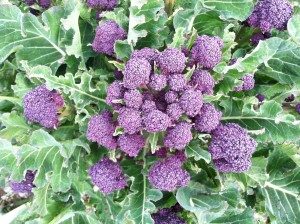
This year we are expanding our purple sprouting broccoli trial sites around the Puget Sound. As part of this effort we’re working to identify the best varieties for various regions and the best transplanting times. We are also providing support and mentoring for farmers who are interested in producing purple sprouting broccoli for seed.
Will you help our research efforts?
We want to hear about your successes and challenges with this crop! What planting times have worked well for you? Are you interested in growing purple sprouting broccoli but haven’t tried it yet? We’ve created a new Facebook group for purple sprouting broccoli growers to connect, share experiences, and ask questions. It’s called the Purple Sprouting Broccoli Bunch Up. Join the conversation today! (Or email our research team directly.)
Why some growers might consider purple sprouting broccoli
Purple sprouting broccoli is a colorful and nutritious crop that overwinters to produce fresh eating in the late winter and early spring. It is well suited to growing regions with fairly mild winters, like in the Pacific Northwest, where temperatures don’t drop much below the teens in Fahrenheit. Planted in the field in late summer — here in Western Washington that’s August — and left to overwinter in the field, plants will produce an abundance of tender stems with bright purple sprouts starting in late February to early March.
Varieties are split into three maturity categories: early, mid, and late. The earliest maturing varieties generally have harvestable sprouts in late February or early March, the mid-maturity varieties come on 2-3 weeks later, and the latest maturing varieties follow after another 2-3 weeks — allowing for a production window of about two months. Two harvests are common for all varieties.
Purple sprouting broccoli provides a delicious, fresh food source at a time when little else is harvestable from the field. During the winter the fully mature leaves can also be harvested and eaten like kale — they are incredibly sweet! — providing additional nutrition throughout the winter. Not only does this timing provide eaters with a fresh local food source after a winter of storage crops, it provides farmers with more income at a time when they need it. Farm expenses are typically higher in the winter and early spring seasons, as this is when farmers are buying their seeds, soil amendments and fertility products, and potting soil for transplants. Organic Seed Alliance has been trialing, breeding, and promoting purple sprouting broccoli for several years now through grant funds from the Washington State Department of Agriculture’s Specialty Crop Block Grant program and in collaboration with organic wholesaler Organically Grown Company.
